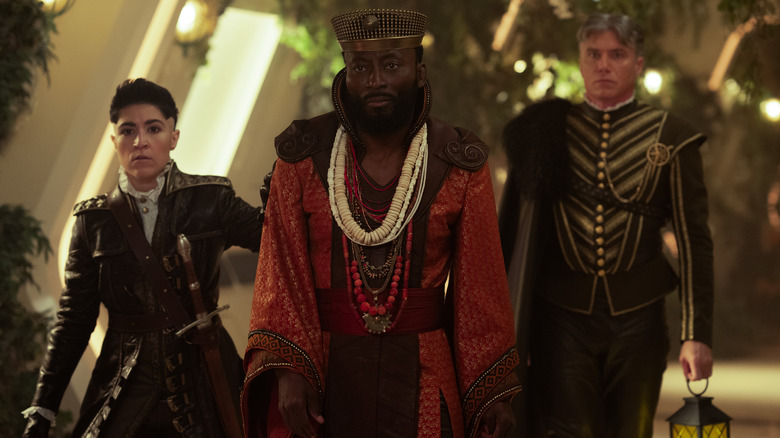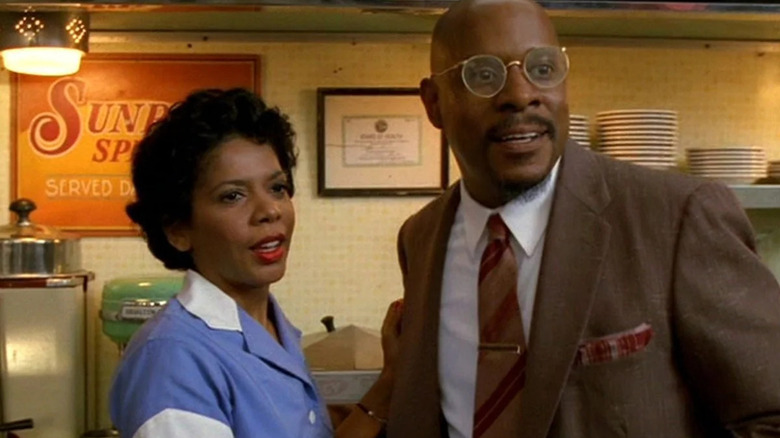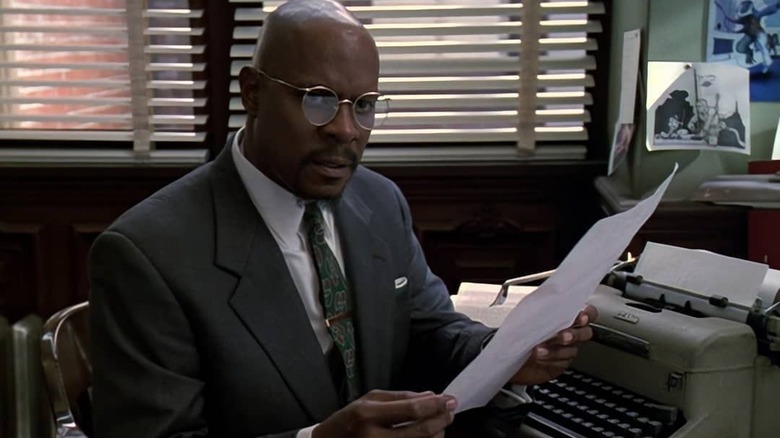Star Trek: Strange New Worlds Features One Heck Of A Deep Space Nine Easter Egg
This post contains minor spoilers for the latest episode of "Star Trek: Strange New Worlds."
Those who have been following "Star Trek: Strange New Worlds" are familiar with the conceit that Dr. M'Benga (Babs Olusanmokun), the chief medical officer on the Enterprise, has a young daughter named Rukiya (Sage Arrindell) who is dying from a fast-acting and incurable disease called cygnokemia. The disease works so quickly that Dr. M'Benga was forced to beam Rukiya into the ship's pattern buffer and keep her in there for extended periods, effectively keeping her body in stasis. While she is in stasis, Dr. M'Benga works on a cure ... to no avail. Every so often, M'Benga will beam her out — she can only remain in the buffer for so long before her pattern would begin to degrade — and read her stories from her favorite fantasy novel.
The conceit of the latest episode of "Strange New Worlds" — called "The Elysian Kingdom" — is that a mysterious mental energy exuded by a seemingly sentient nebula has somehow absorbed the information in Rukiya's favorite fantasy novel and has recreated the characters therein using the Enterprise crew as its avatars. Only M'Benga and the ship's engineer Lt. Hemmer (Bruce Horak) seem to have retained their memories, even if their costumes have changed. The delight of the episode comes from watching otherwise stern characters behave in a wildly outsize fashion; The usually shy Uhura (Celia Rose Gooding) is now an evil queen. The steely, serious La'an (Christina Chong) is now a chirpy, puppy-cuddling princess.
The book from which these characters were extrapolated is called "The Kingdom of Elysian," written by Benny Russell, a name that may be familiar to fans of "Star Trek: Deep Space Nine." Russell was previously featured in "Far Beyond the Stars," a kind-of "what if?" episode wherein the cast of DS9 were sci-fi authors in the 1950s.
Far Beyond the Stars
"Far Beyond the Stars" (originally aired February 9, 1998) was, in many ways, an attempt to bring "Deep Space Nine" back to Roddenberrian notions of an optimistic future. DS9, while brilliantly characterized and morally complex, is a comparatively downbeat show when set next to "The Next Generation," and it would be DS9 that depicts out-and-out war in a universe previously ruled by cautious diplomacy. "Far Beyond the Stars" revealed how far humanity had come from — and how awful things were in — the 1950s, specifically in regards to racism.
In the episode Captain Sisko (Avery Brooks) is granted a vision from The Prophets (a near-divine race of noncorporeal aliens who do not experience linear time) wherein he finds himself living as Benny Russell, a sci-fi author living in 1953 New York. Benny begins writing a sci-fi story that is not too dissimilar from "Deep Space Nine," complete with the show's characters. The rest of DS9's cast (many without their alien make-up) play Benny's co-workers and compatriots. The drama of the episode arises from Benny having written "Deep Space Nine" with a Black captain, a detail that proves to be a racist bugaboo for his editor. Benny, a Black man who faces racism every day, is trying to envision a future where racism has been excised from human vocabulary.
For his dream of a racism-free future, Benny is ultimately institutionalized. He is not permitted to dream, to look up, or to aspire beyond the limits of a racist system. The sci-fi authors he works with are very welcoming — the sci-fi community is more open to diversity — but their protection of Benny doesn't extend past the walls of their office.
Racism and science fiction
"Far Beyond the Stars" is a meta-commentary on the utopian future of "Star Trek," and how, even when the show was made in 1998, racism was still something of an issue for the makers of modern TV; there weren't many high-profile sci-fi shows with a Black lead. "Far Beyond the Stars" reminded us that, yes, we've come a long way, and that, yes, we have quite a long way to go to reach a post-racism "Star Trek" world. It's likely not a coincidence that the same year "Far Beyond the Stars" aired, author Samuel R. Delaney penned an essay for the New York Review of Science Fiction called simply "Racism and Science Fiction," addressing the genre's addressing of a grievous social injustice. Delaney's own story can be seen in Benny; in the book "Black and Brown Planets," Delaney revealed one of his books, "Nova," was rejected by an editor because audiences "wouldn't be able to relate" to a Black main character.
It's significant, then, that Dr. M'Benga — even in a lighthearted fantasy scenario — is selected to serve as the avatar protagonist of Benny Russell's novel. In "The Kingdom of Elysian" (Elysium, a word for Heaven), both the benevolent king and the evil queen are Black characters, a detail that Benny Russell no doubt insisted upon. That people in Trek's distant future are still reading Russell novels prove that he remained significant enough an author to remain in print for centuries. Benny Russell's legacy is now, with a cute Easter egg, secured and important.
The reference to Russell, then, lends "The Elysian Kingdom" a casual, unspoken commentary. For the most part, it serves as a "goofy" episode wherein Pike (Anson Mount) can play "sniveling," and space aliens can scoff at the idea of wizardry, but it also gives Dr. M'Benga a connection to a larger "Star Trek" myth beyond the character's previous appearances. "Star Trek," it says, is set in a world where we have indeed come a long way.


